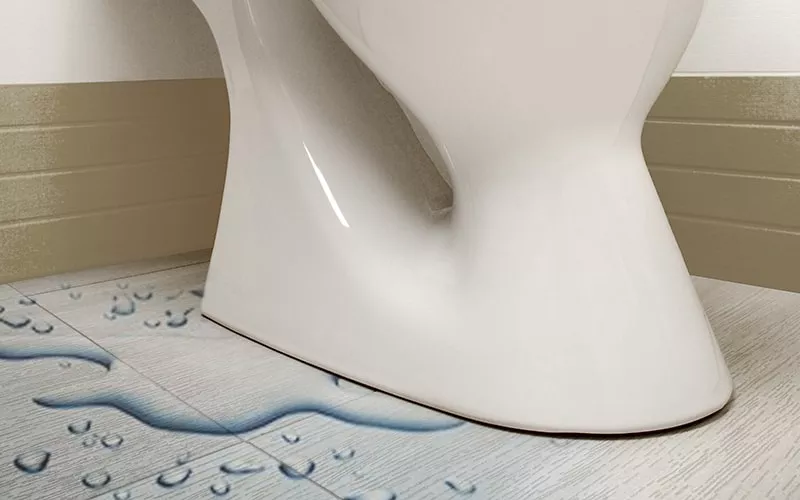
Few things are worse than dealing with a leaky toilet. Chances are pretty good that you will deal with a cracked or broken toilet tank at least once in your lifetime. Leaky toilets are a nuisance and if you do not repair the leak, a small problem can become a catastrophe. That's why it's so important to know how to fix a leaking toilet tank.
Many who find their toilet tank leaking initially panic because they don't realize just how easy it is to fix. Our aim is to alleviate those concerns with this easy-to-follow tutorial.
Diagnose the Source of the Leak:
Before we can decide on the fix, we need to understand the problem. The nature of the leak is pivotal in determining the path forward. It's likely that the source of the leak is one of these five scenarios:
- If the tank is cracked, you will need a replacement. Check all around the tank for any sign of structural damage. If you don't find any, then you probably need to...
- If you find the toilet leaking from tank to bowl (specifically around the tank bolts), then replace the wax ring toilet gasket. Whether you're replacing the whole tank or just the gaskets, the fix is basically the same. In both cases, you have to remove and re-install a tank.
- On occasion, undetectable hairline fractures can appear that will leak water into the floor only after flushing. If this is the case, the bowl will need to be replaced.
- If the wax ring is worn down or not properly seated, water can leak out from under the toilet during a flush. If this is the case, the bowl will need to be pulled up off the floor and the wax ring replaced.
- The toilet supply line may be the culprit. Check to see if there is water dripping from the lowest spot on the supply line. If so, try tightening the nuts on the supply line first. If this doesn't fix the problem, you're going to need to either replace the gaskets or replace the whole supply line.
Fix a Leaking Toilet Tank in 7 Easy Steps
Make sure to read all the way through the instructions before beginning, to ensure you understand the complete process and are prepared with all the necessary tools beforehand. This kind of foresight will lead to a smoother project.
- To begin, you will first want to make sure the water is completely shut off to your toilet tank. You can turn off the water to your toilet at the shutoff valve below the tank where the supply line connects to the wall.
- Next, drain your tank completely so that there is no water left in it. After removing the tank lid, you can use a sponge to soak up any extra water in the bottom of the tank that did not drain fully.
- Then, unscrew the tank bolts. Use an adjustable wrench to hold one of the tank bolt nuts and use the appropriate driver to loosen the other bolt which is found inside the tank. Continue the same process until both bolts are removed from the tank.
- Now, remove the tank from the toilet and carefully lay it down upside down on the floor. (Use a towel or other soft surface if you are in a bathroom with a tile/stone floor) If the tank is too heavy, or you are worried about breaking it, it might be a good idea to get some help from a friend or family member.
- You will then remove the old spud gasket and insert a new one. If you are having a hard time getting the old spud gasket off of the tank, you may need to use an adjustable wrench or better yet, a flat-head screwdriver to loosen and then pry it off. (be careful not to put too much pressure against any ceramic surfaces).
- Next, you will want to remove any old bolt gaskets or rusty bolts and replace them with new ones. You can use a wire brush to scrape off the residue from old bolts or gaskets that may be stuck to your tank. Once you have a clean surface, you can now install the new gasket and bolts, then re-install the tank.
- With the hardware that you removed from the tank earlier, or the new hardware you bought to replace it, reposition and secure the tank. Once you have your toilet tank back into place on top of the toilet bowl. You can tighten the bolts and nuts with a screwdriver and adjustable wrench. Test it out by opening the supply valve, filling the tank, and flushing the toilet. (Pro Tip: Tighten the bolts a little at a time, alternating between the left and right bolts. This will ensure a proper leak-free seal while maintaining a level tank, and reduces the chance of cracking the tank)

Save on Repairs with PlumbersStock
Remember, you can save big on toilets, and the parts and tools necessary to complete this project, right here at PlumbersStock, and at an affordable price. Try this Bemis 1200SLOWT-168. Thanks for reading. Remember to have all the right plumbing tools on hand when you begin your project. Let us know if you have any pro tips for dealing with a leaking toilet tank.
Find other how-to plumbing tutorials here on the PlumbersStock.
Related Resources:
Measuring a Toilet Rough-In
Replacing a Toilet Flange
Replacing a Toilet Supply Line



